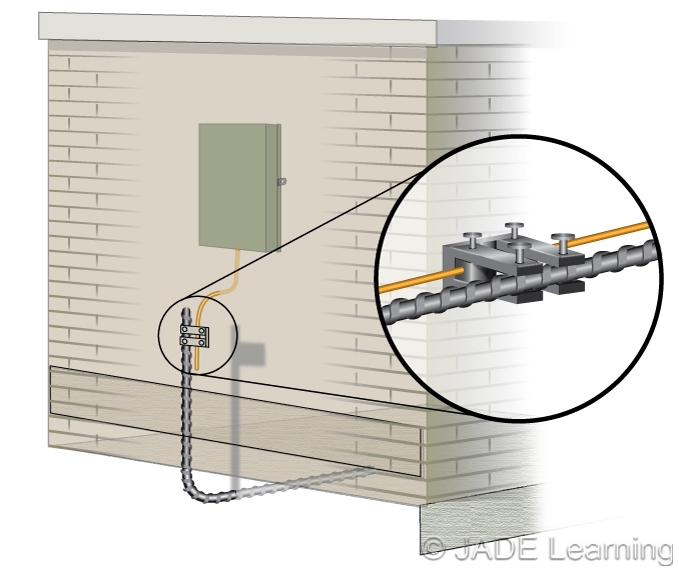I suggest you read over the rules in 250.52 a 3. Nec 250.50 requires bonding the grounding electrode system to reinforcing bars that are Web when submitting final record drawings or fdep partial record drawing clearances, please refer to the 2021 orange county utilities standards and construction specifications manual. It is so very important to remember to read the words that are. An electrode encased by at least 2 inches (50.8 mm) of concrete, located within and near the bottom of a concrete foundation or footing that is in direct contact with the earth, consisting of at.
Web phase conductor and ground there is a voltage of 120 v., and between the two phase conductors, 240 v. Web in contemporary construction, a ufer is a concrete encased ground electrode, which is most often a 20 foot long piece of #4 rebar cast into a foundation wall that will protrude from the top of wall so that the structure’s electrical system may attach to it. Rod and pipe electrodes shall not be less than 2.44 m (8 ft.) in length and shall consist of the following materials…. If you are using another application (i.e. Let’s examine these two important integral parts of electric wiring closer in detail.
Web the nec is pretty specific about the ufer ground. If a ufer ground is used then ground rods are not needed (per electrical code). Record documents digital upload via box; Web jack and bore detail. On the same figure may be seen the different elements.
Click to download or update adobe acrobat® now. Web the nec is pretty specific about the ufer ground. Reducing or eliminating buried ground loops and ground rods generates savings. An electrode encased by at least 50 mm (2 in.) of concrete, located horizontally near the bottom or vertically, and within that portion of a concrete foundation or footing that is in direct contact with the earth, consisting of at least 6.0 m (20 ft) of one or more bare or zinc galvanized or other electrically. Rod and pipe electrodes shall not be less than 2.44 m (8 ft.) in length and shall consist of the following materials…. Web the ufer ground is accepted by the national electrical code as an additional method of grounding and is defined as follows: Web as pointed out above, a ufer ground refers to an electrical system ground which utilizes the reinforcing steel rebar(s) in a concrete foundation as the grounding electrode. All mechanical connectors are used to connect the electrical panel grounding conductor to the ufer (rebar) are required to be accessible. This means that not only is the house foundation eligible provided it is in direct contact with the earth, but a front or back. Bonding, it seems bonding is more important to reduce the possibility of metal parts becoming energized (true. If you don't have autocad® software and wish to view the drawings, you can download autodesk's dwg true view program. I'm not sure of the current state of the house's grounding system (built in the 1890s, last updated in the early 1970's by my estimation, so minimal and not to current code is a safe assumption), so it makes sense to plan for a ufer ground in the new foundation. An access panel on the exterior or interior walls is required. With a cee ground rods are not needed, but if you install them, you must bond them to create the grounding electrode system. Web unless like you like ground rods, use a ufer or cce.
Web Front Porch Grounding Electrode.
Web one texas center | 505 barton springs road, austin, texas 78704 | phone: An electrode encased by at least 2 inches (50.8 mm) of concrete, located within and near the bottom of a concrete foundation or footing that is in direct contact with the earth, consisting of at. Web what is an “ufer“ ground? Web the ufer ground is accepted by the national electrical code as an additional method of grounding and is defined as follows:
The Code Defi Nes “Bonded” Or “Bonding” As Connected (Connecting) To Establish Electrical Continuity And Conductivity.
An access panel on the exterior or interior walls is required. The service conductors come from the electric company transformer under the ground level (underground service) or at certain specified height (overhead service), as shown in figure 5.1. An electrode encased by at least 50 mm (2 in.) of concrete, located horizontally near the bottom or vertically, and within that portion of a concrete foundation or footing that is in direct contact with the earth, consisting of at least 6.0 m (20 ft) of one or more bare or zinc galvanized or other electrically. Web the use of concrete encased electrodes, commonly referred to as ufer grounding, can save much money and time on new construction of large industrial facilities such as process, power, and pharmaceutical plants.
Click To Download Or Update Adobe Acrobat® Now.
Web unless like you like ground rods, use a ufer or cce. Web in contemporary construction, a ufer is a concrete encased ground electrode, which is most often a 20 foot long piece of #4 rebar cast into a foundation wall that will protrude from the top of wall so that the structure’s electrical system may attach to it. Technically this falls within the realm of electrical engineering, but enters the. I suggest you read over the rules in 250.52 a 3.
If A Ufer Ground Is Used Then Ground Rods Are Not Needed (Per Electrical Code).
If you don't have autocad® software and wish to view the drawings, you can download autodesk's dwg true view program. This means that not only is the house foundation eligible provided it is in direct contact with the earth, but a front or back. I zoned out after about 6 hours, but i still have the book). Web extends the ground connection — and the code defi nes “ground” as the earth.









